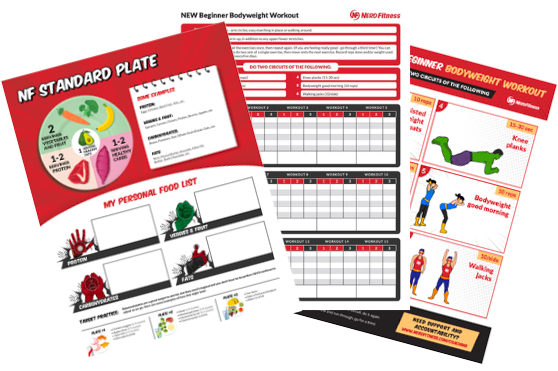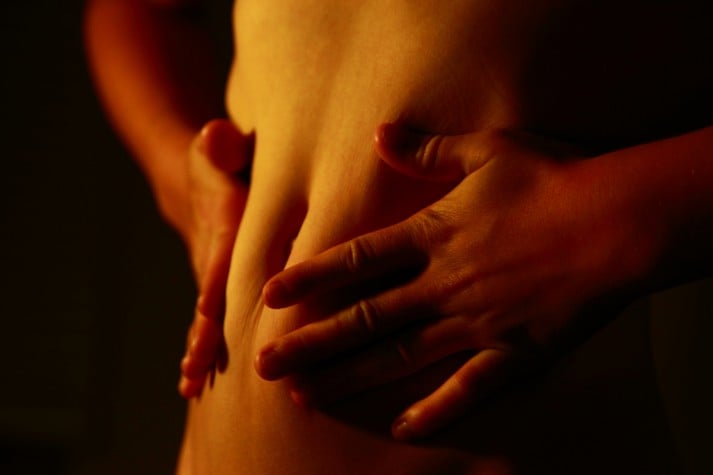
This is a collective effort article, lead by NF Team Member Staci.
We get a ton of emails from people asking how to change. How they can lose weight, change their body shape, get those elusive abs, etc.
This is not surprising. Studies have shown that up to 97% of women and 80% of men are unhappy with their bodies and overall appearance.
One of the big concerns we hear from people is that they are so uncomfortable about their appearance that they are afraid to even step foot in the gym.
The “ideal” body is thrust upon us at every turn – from the doctor’s office, to movies, to magazines. It brings up a lot of questions:
Should we be comparing ourselves to a particular image?
Is there anything wrong with having goals that are purely physical?
Is there anything to this idea that we should all be comparing ourselves to a collective image?
If not, what CAN we use?
Let’s find out!
What is ideal?

Walk through any grocery store aisle and you will be greeted with magazines with phrases like:
- “Lose weight without dieting!”
- “Slim Down the Easy Way”
- “Lose Inches All Over!”
For guys, it usually sounds like:
- “HOW TO GET SIX PACK ABS”
- “Gain Muscle Fast With these Moves”
- “Bigger arms now!”
The media tells us that women need to be as tiny as possible, and men should be big, muscular, and have washboard abs.
AKA women need to look like Barbie, and men should look like He-Man.
Female models are photoshopped to “perfection,” removing any cellulite, blemishes, increasing bust size and often removing inches off of their bodies. Having any sort of muscle tone is considered a negative, and when celebrities start to get fit, they are constantly put down by the media. When they are featured in magazines, their muscles often airbrushed off.
And for men, of course, there are plenty of unattainable standards as well. You should be tall, with huge arms and 6 pack abs, or you’re not a real man. So, all focus has turned to getting rid of your “beer belly” and “moobs” and how “to get shredded!” Even video games can reinforce these current “standards” for men.
These standards pushed upon us from every direction, touting that one body shape and size is the “ideal” for everyone…that we should all strive for it at the expense of everything else.
The first question we should be asking is “why?” Not only are there naturally many different body types, shapes, and sizes, but the ideal they are pushing on us is actually only found in less than 5% of the population.
Now you might be thinking: “I thought this was all getting better!?”
Not exactly.
All over the internet, people are screaming things like: “Strong is the new skinny!”/” Strong is the new sexy” / “REAL women have curves!”
While we appreciate the sentiment that women should be strong, and that it’s okay to not be stick thin or have curves – all of these posts have one common theme: they are all still saying that one body type is better than another.
Here’s the truth: some women are naturally very skinny – and will struggle to look “curvy.” Others may be naturally “curvy” and will struggle to look skinny. Some guys can pack on muscle, others are very, very thin.
Here’s the truth: strong is healthy, and healthy is sexy. You can be skinny and strong and you can be curvy and strong. It doesn’t matter what shape you are – health is what’s sexy and attractive and what we should be touting.
At the end of the day, efforts to thrust one body type forward as the be-all end-all physique don’t solve anything.
Instead, it just shifts the problem from one group to another.
Everyone likes something different
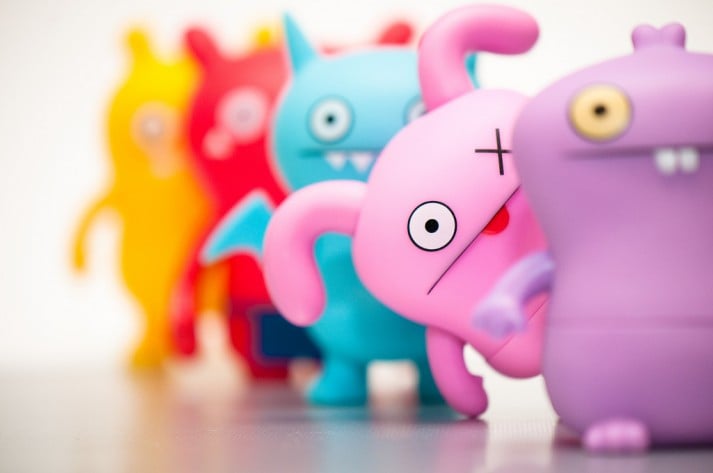
Magazines poll all the time on which body is the most preferred – both for males and females.
The results are never consistent and depend on the country you’re in and who is being polled. The only constant thing about these polls is that everyone likes something different – both in themselves and the sex they’re attracted to. When there is a consensus around average body type, it’s exactly that: an average of a diverse set of opinions.
So, the question again is this: “Why is this something we’re even discussing?”
We were all born with different body shapes and sizes – does it matter what others prefer?
After all, our standards of “perfect” and “ideal” are entirely fickle, dependent on the time and culture.
Take a look at two major male sex symbols in their own time, Marlon Brando and William Shatner (Captain Kirk). These guys aren’t shredded, with waxed chests, and 6-pack abs like every cover of Men’s Health ever. Instead, in their time the “ideal” look was simply strong, without being too lean.
One of the best examples of this can be seen by looking at some of the actors playing batman throughout the years. Or James Bond.
Women are no different. In the ’40s, ’50s, and ’60s, a product called “Wate-On” helped women put on that last few pounds because “true beauty includes a full figure.” Or take these photos of dancers from the 1890’s, an ideal the mainstream media would no doubt consider “plump” by today’s standards.
And yet, in all these different times with all these different standards, the men and women of their time all sought to conform:
Vintage body modification and cosmetic devices show men of past generations struggling to adapt to their time.
For women, it was anything from corsets to binding their feet.
As far back as we can look, we have been willing to do whatever it takes, sacrificing our health to change our bodies to fit an unrealistic ideal.
So if standards change, and the Hollywood standards of male and female beauty would certainly be odd 50 or 100 years ago – what actually makes the perfect body?
What should you be setting your fitness and weight loss goals on?
Let’s ask the doctors! After all, they would never steer us wrong, right?
Healthy Ideals?
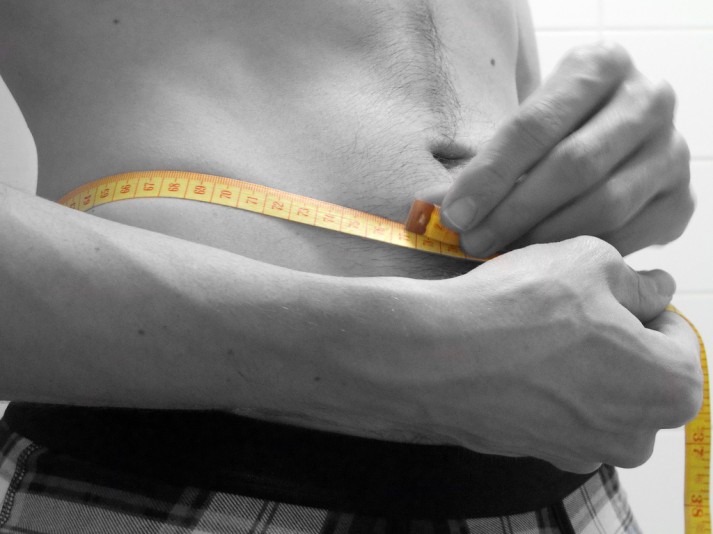
When you step into your doctor’s office, you’re presented with two charts: an ideal body weight chart and a BMI (Body Mass Index).
There are many different calculations for ideal body weight, but they all look something like this:
- 115 lb (52 kg) + 4.2 lb (1.9 kg) per inch over 5 feet (man)
- 108 lb (49 kg) + 3.8 lb (1.7 kg) per inch over 5 feet (woman)
Perhaps the most popular “ideal” calculation used in the medical field is BMI. This calculation isn’t rocket science, but rather taking your weight and dividing by your height.
With BMI you get a number, and in the United States, “healthy” is considered 18.5-25.
Here are Staci’s stats: I’m around 5’5” tall, 150lbs, and around 17-18% body fat. I wear a US size 2/4, or an XS/S in most brands of clothing. Yet, if we plug my numbers into these calculations, I’m at the very top of my BMI (BMI recommends 111.2lbs – 150.2lbs), and my “ideal weight” is around 123 lbs. Not only am I almost considered overweight, but to hit my ideal weight, I would have to lose 27lbs.
The last time I hit a weight that low, I was wearing a child’s size 12 and was told I’d be admitted to the hospital if I didn’t gain some weight immediately. While 123 lbs is a good weight for a lot of women who are 5’5″, my frame size is too large to support that little weight.
So how are these numbers so off if they’re used so frequently as the “ideal” by our doctors? If you look at the calculations, they only use two main variables – height and weight. You can’t possibly tell me that every single person on this entire planet that is 5’5” tall should weigh the exact same.
We all have different body types, frame sizes, body fat percentages, etc., and will look different even at the same weight.
Simply put: there’s no easy way to create a standard for what a human should weigh because we are all so very different in so many ways. Yes, if you are overweight and don’t exercise then BMI is a decent starting point for determining level of ‘health,’ but it’s fractional at best.
So why are they used? Because there’s no overly accurate way to calculate body shape and frame size (there are a few methods, but they’re about as accurate as BMI), and this is something a busy doctor can quickly calculate and measure in seconds.
We address BMI (and how to calculate your body fat percentage, a far more accurate method for determining if you’re “healthy”) in this epic post, if you’re interested in nerding out on the subject 🙂
who do we listen to?
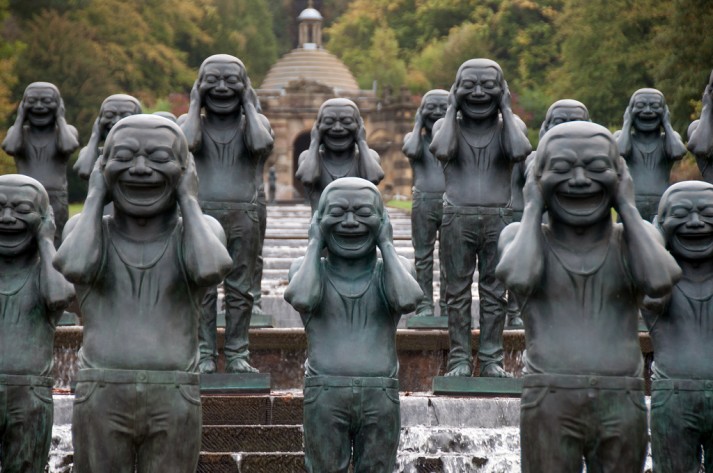
It’s always funny to see a picture of a strong woman (with you know, a bit of muscle) posted on Facebook or Twitter.
It usually doesn’t take long until there are a few comments about how girls shouldn’t have muscles because they prefer their girls to be either skinny, curvy, or whatever the “ideal” happens to be.
But for some reason, instead of just not dating girls with muscle (because there are plenty of guys who DO like skinny girls, curvy girls, or girls with muscle) – they need to make a comment and to tear down the person in the photo.
For guys, it’s often the same story; you will see comments about how they are too scrawny, that they have chicken legs, or the exact opposite, how they MUST be using steroids and that they are vain.
When Hugh Jackman posted a photo of him at 44 years old deadlifting 400+ pounds on twitter, the internet immediately started making fun of him and telling him “don’t skip leg day, bro” because his legs weren’t tree trunks, or that they could lift more than him because, it’s the internet.
Sigh. As a skinny nerd with chicken legs who never skips leg day, Steve can sympathize with Wolverine.
When Staci’s success story came out, there were discussions on a few different sites on whether or not she should have lost the weight at all. Some argued she was more attractive at one weight, while others argued for another. Sometimes they even critiqued specific body parts. Other’s emailed Nerd Fitness letting Staci know exactly why she was wrong for losing weight and altering her physique.
So, Staci took an important next step: She quickly stopped reading any discussions about her outside of Nerd Fitness. She didn’t change her body and lifestyle to make herself more attractive to some random dude on the internet – she changed her life for HER health and FOR HER.
The truth is, when you listen to polarizing comments and opinion articles on the internet about body shape and size, you’re letting some random person you don’t know dictate what is arguably the most important part of your life: your body.
For example: one of the biggest trends in women’s body image right now is the “thigh gap” – which is better known as “feet together, thighs apart.” On sites all over the internet young women are told that this is the ideal look. But in all reality, many women are physically incapable of achieving this due to their natural body size without being deathly thin.
So why do we let trends like this influence our bodies?
And why are there even body shape trends at all?
Hell, even Olympians – the worlds BEST athletes – don’t fit into the same ideal – some of them are smaller and others larger. Some of them have more curves, while others have more lean muscle. Who is to say that the basketball player has a more perfect body than the marathoner? They are both healthy and using their bodies to do what they love.
I’m sure many people would tell you that they personally preferred the look of one over the other – and that’s great.
That’s a part of being human! We are supposed to all like different things. How boring would it be if we all liked the exact same thing?
Going too far the other way…

Just as comparing yourself to those you can’t possibly live up to is dangerous, so too can it be dangerous to compare yourself to those who are unhealthier than you.
If you are 300 pounds and incredibly unhealthy, it’s not wise to simply find a 350 pound guy to think “welp, it could be worse! At least I’m better off than that guy!”
We’ve all done it. Whether its justifying a bad decision we made, staying in a situation that we should have long gotten out of, or simply choosing not to improve ourselves in some way, we justify our behavior by finding those worse off than us and saying “at least I’m not him/her.”
We call this “good enough” syndrome,” and it can be equally detrimental.
What it all means: The only person whose opinion on your body matters is you. The only person you can accurately compare yourself to is YOU from yesterday/last week/last month/last year.
A better version of you is all that you can strive to be.
The pursuit of ideal
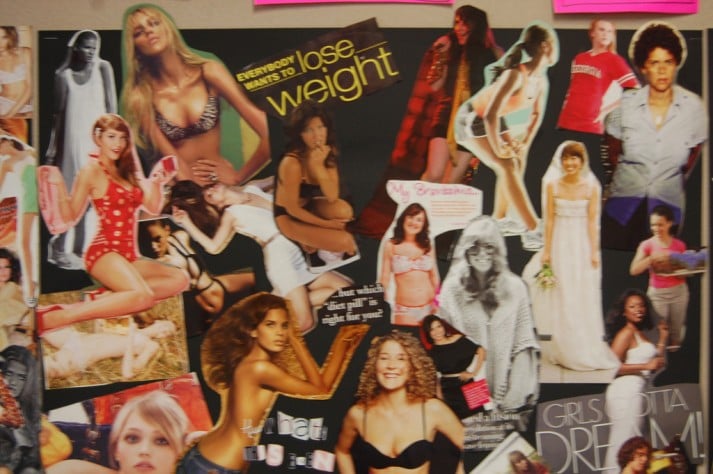
So if we can’t use the media, doctor’s charts, or other people to tell us what is perfect, then what DO we use?
Sit back and ask yourself two questions:
- Are you healthy?
- Does your body allow you to do the things you want to do in life?
If you answered yes to the above two questions, then your body is ideal.
Ideal is when your body is built for doing what you want to do, to the best of your abilities. You are always going to be switching “ideals” depending on what you are doing in life and as your goals change.
- If you want to be a marathon runner, your ideal would be building a body that is optimized for endurance.
- If you want to be a power lifter, your ideal might be a body with more body fat and muscle than you currently have.
- If you want to be a martial artist, your ideal might be a very low body fat percentage and muscles built for power.
Steve’s physical goals constantly change depending on the ‘version’ of Steve he’s trying to build. These changes are a result of goals that he has set for himself, not to live up to somebody else’s standards.
Look at someone like Ali McWeeny – a powerlifter who lost one of her legs in an accident. Despite her misfortune, she does what she loves, is healthy, and is kicking more ass than ever. This is her ideal.
What if you answered NO to one of the questions each week?
Then it’s time to make some changes.
And that’s what we’re here for. To help you understand how your body works, and how you can improve it to achieve your desired results.
In the Nerd Fitness Rebellion, health is number one above all else. Don’t worry about numbers on the scale and focus on small changes that add up to big changes. Start making small changes today, not tomorrow. Get moving now.
How to define your own ideal
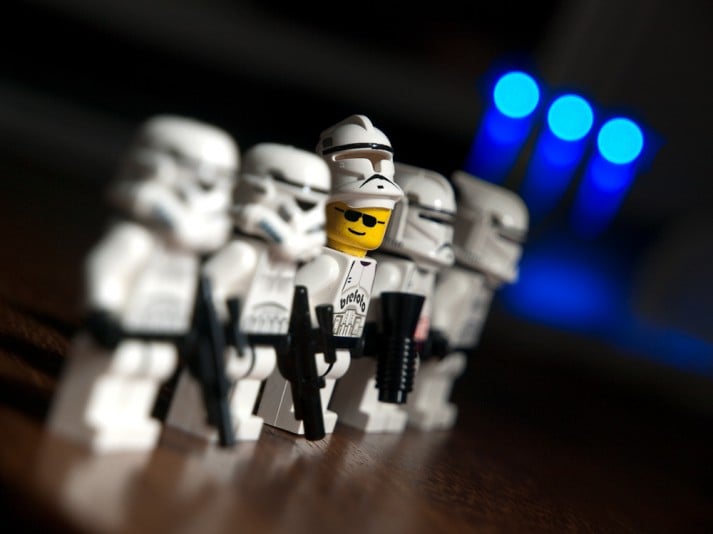
Let’s face it, even if you didn’t answer “no” to one of the questions above, statistically almost all of us are unhappy with our bodies in some way. We’re Rebels in the heart of the Empire.
Let’s take a look at some of the ways you can fight back and level up your life without following the herd off the cliff:
Focus on performance goals, such as reaching a 300 deadlift or doing a handstand, instead of adopting purely body shape and size goals. When you adopt only physical goals that reinforce the false ideal, you’re selling yourself short and focusing on one of the least important parts of your transformation. Instead, focus on doing new and awesome things, and that “ideal body” that you want will follow.
REMEMBER: Appearance is a consequence of fitness!
Do what you want to do, and enjoy every second of it. Seek out activities that improve your health THAT MAKE YOU HAPPY. If you hate your workout, you are doing something wrong. Find something that can be a reward in itself, not just a means to an end. Turn the attention away from the “perfect body” you are striving for, and instead focus on the here and now.
Enjoy each new level, rather than just scrambling to get to the end-game “credits” screen.
Be proud of your achievements as they come. Put a focus on celebrating achievement and hard work. That’s what the W00T Room is for! Make your victory about the obstacles you overcame and your new capabilities, not only about your improved appearance. Recognize that the level 50’s you see didn’t go from sedentary to awesome over night. Be proud of each and every small step.
Surround yourself with Rebels. No matter how hard we fight back, the “ideal” is all around us. Magazines, commercials, movies, and even ingrained in friends and loved ones. Counter this effect by bringing some balance to the force: surround yourself with Rebels. This could mean actual Rebels over at the Nerd Fitness Rebellion, or any group of people who value health and performance over random ideas of appearance.
Realize that you can’t change certain things about your body. We get many emails from people asking how to get rid of stretch marks, cellulite, or how to get rid of loose skin. The truth is, there’s no magic pill or cream that can make any of these go away. These are all natural things that happen with our bodies and nothing to be ashamed about. Yet people will not go outside wearing shorts or take off their shirt at the beach because they are afraid of what other people will think.
If you have stretch marks from being pregnant: YOU CREATED A HUMAN with your body – be PROUD of those stretch marks.
If you have stretch marks or loose skin from losing weight: be PROUD that you won the battle and lost all of that weight.
Wear those battle scars like badges of honor: not as imperfections or problems, and be proud of your journey.
Realize that nobody out there is as critical about your body as you are – and that things that you consider negatives about your body could be the goals that others are working their butts off to try to achieve. The things that Staci used to hate about her body are the things that she get complimented on the most.
Try this: When looking in the mirror, think/say one positive thing instead of something negative. As soon as you think anything negative, step away.
Instead of saying “my hips are so big” or “my arms are so scrawny,” say “I love how my body curves” or “I look really strong today.” I know it sounds silly, but simply saying something positive about your body out loud every day can gradually change your perception.
The most attractive thing about any person is a combination of health, confidence, and happiness.
If you ever hear someone talk about a child when it is just born – one thing you will hear over and over again is that the child is perfect in every way because it’s healthy.
Despite what we might think, this doesn’t change as you get older.
Be you
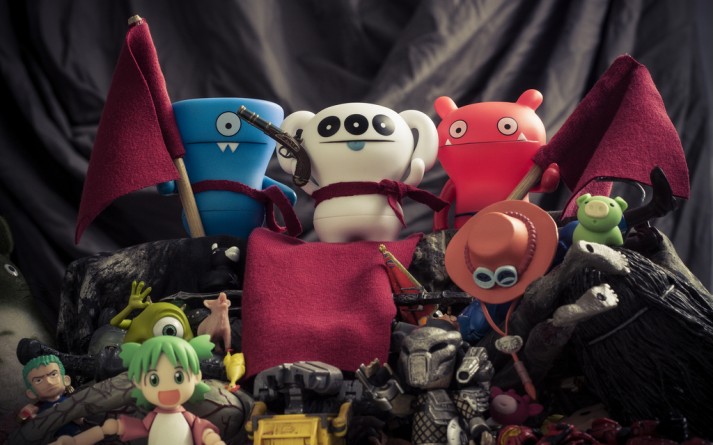
At the end of the day, the only thing you can work on is becoming the best version of yourself.
“Ideals” can’t be trusted, who knows where they’ll be in five years or ten, and they are unrealistic for the majority of the population anyways. Sheesh, the models you are looking at don’t live up to the photoshopped versions of themselves! Even Cindy Crawford says that she wishes that she looked like Cindy Crawford.
There’s a drastic difference between reality and the idealized “reality” that’s put in front of us. Never forget that.
Don’t fall into the trap of letting others set the standards of your health and beauty. You can spend your time on this planet changing yourself to meet the standards of others, or you can realize your own beauty and be proud of it.
Constantly push to better yourself, to become your own ideal.
Rebels come in all shapes and sizes. We like weightlifting, marathons, strongman competitions, gymnastics, parkour, swimming, yoga, live action role-playing, and everything in between.
We’re a community of diverse awesomeness, and we’re glad you’re here.
Just by being here and seeking a better life, you are ahead of 90% of the population.
Stop worrying.
Let go of the anxiety, let go of the constant struggle, enjoy being who you are, and start leveling up your life today.
Let’s get the discussion started:
How have you been able to block out unhelpful comments and comparisons?
What are your thoughts on body image?
Are things getting better? Or is it more of the same?
Is “strong is the new skinny” inspiring, or detrimental?
Words of advice for those struggling with this stuff?
-Staci
###
photo source: belly, statue, Mona Lisa, characters, tape measure, ideal, sleeping animal, rebel, runner


